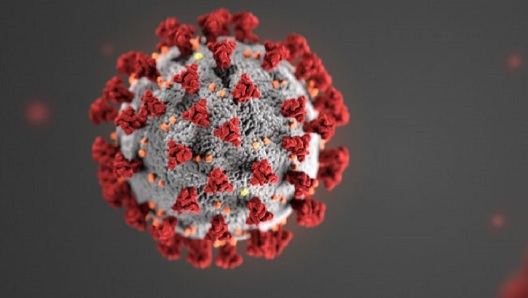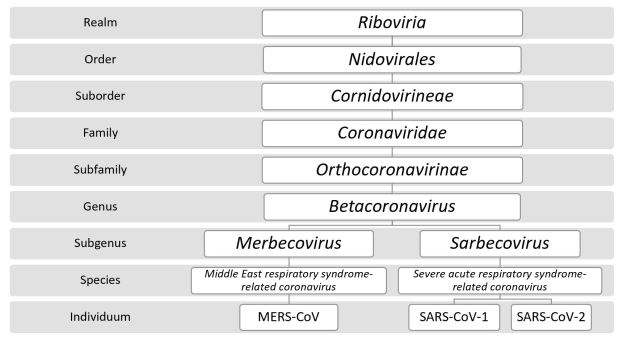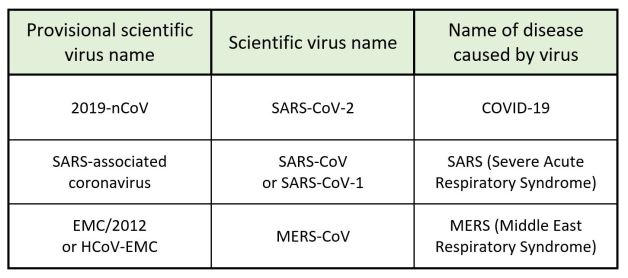Let’s get straight to it. COVID-19 needs no introduction.
Or does it? What is the coronavirus? Most of us can recite the symptoms of infection. We know the devastating toll it is taking on our communities and loved ones. But what exactly are we all up against?
What is the coronavirus?
The coronavirus is actually a coronavirus. Coronaviruses are a type of virus, named for their crown-like appearance. In Latin, corona means “crown, garland, or wreath.”

COVID-19 showing crown-like protrusions. (Image credit: Centers of Disease Control and Prevention)
There are hundreds of different coronaviruses. Most of these coronaviruses only infect other animals, including dogs, cats, bats, snakes, and birds. There are other coronaviruses that infect humans. Almost all humans have had a coronavirus at some point in their life. The common cold can be caused by a coronavirus infection.
Confused yet? Let me clarify, because this is extremely important to finding and understanding scientific research articles about the right kind of coronavirus, and not a coronavirus that causes the common cold or one that only infects dogs.
A virus by any other name…
In order to get a handle on this, we’re going to need to backtrack for a second. If you’ve taken a biology course, you are probably familiar with biological classification, or, taxonomy. Biological taxonomy describes, names, identifies, and classifies living organisms into a hierarchical system:
Domain > Kingdom > Phylum > Class > Order > Family > Genus > Species
However, scientists are unsure if viruses are living organisms. Because of this, viruses have their own classification system. The International Committee on Taxonomy of Viruses (ICTV) classifies viruses in the following manner:
Realm > Order > Suborder > Family > Subfamily > Genus > Subgenus > Species > Individuum
When a new virus is found, it receives a provisional name. Research is conducted to determine the newly discovered virus’s relationship to other known viruses. This is done by looking at the virus’s protein structure, allowing scientists to infer how the virus functions and what its place is in the ICTV classification system.
The virus causing a pandemic today was provisionally named 2019-nCoV, communicating that it was a) discovered in 2019; b) novel, or new; and c) that it belongs to the coronavirus family of viruses. Further research on the protein structure of 2019-nCoV, showed that the virus’s genome is most closely related to the virus that causes SARS (Severe Acute Respiratory Syndrome). It is also related to the virus that causes MERS (Middle East Respiratory Syndrome). Both of the viruses causing SARS and MERS belong to the coronavirus family.
Following this discovery, 2019-nCoV was renamed to SARS-CoV-2, communicating that the virus’s protein structure is more similar to the virus that causes SARS.
It’s important to know that the virus that causes Severe Acute Respiratory Syndrome used to have the scientific name SARS-CoV, but is now named SARS-CoV-1. The scientific name for the virus that causes Middle East Respiratory Syndrome is MERS-CoV. You may see these two viruses and their scientific names mentioned in research articles, because they are useful for comparative research and learning more about SARS-CoV-2.
The disease caused by SARS-CoV-2 is named COVID-19, a decision made by the World Health Organization. COVID-19 (short for coronavirus disease 2019) was chosen so the public would not confuse the disease with SARS – they have similarities, but they are not the same!

Taxonomy of SARS-CoV-2, SARS-CoV-1, and MERS. (Image credit: Michelle Speed)

Names of viruses and the diseases they cause. (Image credit: Michelle Speed)
*EMC stands for Erasmus Medical Center; HCoV stands for Human Coronavirus
Finding scholarly journal articles about SARS-CoV-2 and COVID-19
Why does any of this matter if you are looking for research articles? The short answer is that academic databases are picky about terminology, and so are the authors of these articles. You are forced to be precise with your search terms. Despite the seeming drawbacks, this is a good thing! A well-targeted, specific search will retrieve exactly what you need. Plus, if you want to read and understand these articles, it’s essential to understand the scientific names they are using.
Bad search term:
- Coronavirus – This will pull up too many articles, most of which are about other kinds of previously-known coronaviruses.
Good search terms:
- 2019-nCoV – This was the provisional scientific name of the virus. If you are looking for research conducted prior to March 2020, use this search term.
- Novel coronavirus 2019 – This term was originally used by the World Health Organization to describe the disease that is now called COVID-19. It will retrieve articles written before February 11, 2020.
Better search terms:
- SARS-CoV-2 – This is the scientific name of the virus. It will retrieve articles written in March 2020 and later.
- COVID-19 – This term will retrieve articles about the disease caused by SARS-CoV-2 that were written after February 11, 2020. It may or may not retrieve articles about research done on the virus. For example, a search for COVID-19 won’t bring up all the articles about how long the virus lives on different surfaces, but it will bring up all available articles about lung damage.
Accessing peer-reviewed scholarly journal articles about SARS-CoV-2 and COVID-19 on the web
The majority of scholarly journal articles are typically behind a paywall. However, during the pandemic, a great number of academic publishers and providers have made their content about SARS-CoV-2 and COVID-19 free to everyone. Some of these resources are freely available for a limited time only.
Links are presented in no particular order.
LitCovid
A curated hub for tracking up-to-date scientific information about SARS-CoV-2 and COVID-19. LitCovid is a comprehensive resource, providing access to a growing number of relevant articles in PubMed. Articles are updated daily and are categorized by research topic and geographic location.
CDC Publications
A selection of research articles from the Centers for Disease Control, the CDC’s Division of Viral Diseases, and the National Center for Immunization and Respiratory Diseases.
The Lancet
The Lancet is a long-standing, well-respected medical journal. Their Coronavirus Resource Center is a central place to access to all Lancet articles about SARS-CoV-2 and COVID-19. Articles are made available for free as soon as they are published.
The New England Journal of Medicine
Another journal with a reputation for excellence and longevity, The New England Journal of Medicine is providing all of their articles and resources on the COVID-19 outbreak for free. This includes clinical reports, management guidelines, and commentary from experts.
The JAMA Network
The Journal of the American Medical Association (JAMA) Network is providing access to their COVID-19 scholarly journal articles, in addition to Q&A’s with Anthony Fauci (the director of the National Institute of Allergy and Infectious Diseases). Also available for free are past publications about vaccine development, infection control, and public health preparedness.
Cell Press
Cell Press is a collection of academic journals that include Cell, Current Biology, Cell Reports, and Immunity. The Cell Press Coronavirus Resource Hub consists of selected research and commentary from Cell Press academic journals and trend review journals.
The BMJ
The British Medical Journal (BMJ) is another source of high-quality scientific articles. In addition to being a free collection of peer-reviewed articles about the pandemic, The BMJ provides resources for clinicians, best practices, learning modules, thoughtful and well-designed infographics, and much more.
Cambridge Core
From Cambridge University Press, Cambridge Core provides access to academic journals and academic books. Cambridge Core is currently giving free access to articles about SARS-CoV-2 and COVID-19 via their Coronavirus Free Access Collection. New articles are added daily.
Wiley Online Library
Wiley is an academic publisher of books and academic journals in the sciences. Wiley is making all of their journal articles and book chapters about SARS-CoV-2 and COVID-19 available for free. Their website is updated according to the following frequency: “On workdays, newly published articles are made free within 24 hours of publication. Articles published after 14:00 (EST) on Friday will be made free the following Monday.”
World Health Organization Situation Reports
Beginning January 21, 2020 to the time of writing, the World Health Organization provides free daily situation reports about the COVID-19 outbreak.
Nature
Nature has curated a collection of articles including research into the basic biology of SARS-CoV-2 infection, its detection, evolution, treatment of COVID-19, research into the epidemiology of emerging viral diseases, and coverage of current events. Articles at Nature are free to access, as long as the outbreak remains a public health emergency of international concern.
Oxford Academic Journals
Oxford University Press has created a continuously updated collection of academic research articles, chapters from relevant academic eBooks, and chapters from Oxford Medicine Online. Oxford’s free content is not only about SARS-CoV-2 and COVID-19, but includes information about public health, policy, social and economic effects, and more.
Elsevier
Elsevier is a publisher of academic journals and books. Elsevier’s Novel Coronavirus Information Center provides a great deal of free information in several areas related to the COVID-19 pandemic. One of the many resources provided by Elsevier is free access to articles about SARS-CoV-2 and COVID-19 via their platform ScienceDirect.
Science
Science is a publication of the American Association for the Advancement of Science. All articles about SARS-CoV-2 and COVID-19 are available for free.
American Chemical Society
The American Chemical Society (ACS) is providing free access to research articles pertaining to the intersection of chemistry and SARS-CoV-2 / COVID-19. This includes older articles about stemming viral outbreaks, viruses and environmental engineering, SARS, MERS, and more.
DynaMed
DynaMed, an EBSCO database, is providing free academic information about COVID-19 in an easy to read and understand format.
Emerald Publishing
Emerald publishes academic journals in science, technology, social sciences, business, economics, education, and more. Emerald has created a resource of academic journal articles about SARS-CoV-2 / COVID-19 and the wider societal and economic impact of the pandemic. Sections on Emerald Publishing’s site include scholarly articles about working from home, online education, and logistics.
SAGE Journals
SAGE publishes a number of scholarly journals in many academic disciplines. SAGE has created a resource of free articles relating to SARS-CoV-2 / COVID-19 as they relate not only to medicine, but to the social and behavioral sciences.
SpringerLink
A long-standing publisher of academic journals and books, Springer Publishing has created a vast resource of free academic articles, conference papers, and book chapters. In addition to covering SARS-CoV-2 and COVID-19, topics include epidemiology, infectious diseases, public health, microbiology, chemistry, engineering, and more.
Accessing peer-reviewed scholarly journal articles about SARS-CoV-2 and COVID-19 through NCTC’s Library databases
NCTC students, faculty, and staff ALWAYS have free remote access to a large number of academic databases, including medical and scientific databases. To access these at any time, and from any place, follow these directions:
- Login to MyNCTC with your username and password.
- On the left-hand side of the screen is a link for “Library Services.” Click this link.
- On the left-hand side of the screen is a link for “Library Databases.” Click this link.
- On the Library Databases screen, the username and the password for the databases is listed on the right-hand side of the screen. Make note of the username and password.
- Click on the link for the database you need.
- Enter the username and password you saw on the Library Databases screen.
Quick tips for reading scientific research articles
- You don’t have to read all of it.
- It’s okay if you don’t understand everything.
- You don’t need to read it in order.
- For quicker and better understanding, try reading your article in this order:
-
- Abstract (the overall summary and main points of the article)
- Introduction
- Literature Review
- Discussion
- Conclusion
- Methodology (this section is sometimes difficult, so feel free to skip it altogether)
- Results/Data (this section is sometimes difficult, so feel free to skip it altogether)
-
- Not all articles will have all of the sections mentioned above.
- Don’t be afraid to ask questions.
- Make notes of what you didn’t understand or what you want more information on.
- Most importantly, try your best!
Become an information warrior!
The profusion of news, anecdotes, videos, and social media posts can add to the confusion and anxiety we are all experiencing. As good citizens, we must all be diligent to take the time to educate ourselves by turning to the experts: the scientists and healthcare professionals on the front lines. Do your part. Conduct good searches. Use sources that can be trusted. Learn, learn, learn! Arm yourself in the fight against SARS-CoV-2 and COVID-19 misinformation/disinformation.
Sources [in order of appearance]
“Symptoms of Coronavirus.” Coronavirus Disease 2019 (COVID-19), Symptoms and Testing, Centers for Disease Control and Prevention, 20 Mar. 2020, https://www.cdc.gov/coronavirus/2019-ncov/symptoms-testing/symptoms.html. Accessed 23 Mar. 2020.
“Coronavirus COVID-19 Global Cases by the Center for Systems Science and Engineering (CSSE) at Johns Hopkins University.” Coronavirus Resource Center, Johns Hopkins University & Medicine, 26 Mar. 2020, https://coronavirus.jhu.edu/map.html. Accessed 26 Mar. 2020.
NIAID Now. “New Images of Novel Coronavirus SARS-CoV-2 Now Available.” News & Events, News Room, NIAID Now Blog, National Institute of Allergy and Infectious Diseases, 13 Feb. 2020, https://www.niaid.nih.gov/news-events/novel-coronavirus-sarscov2-images. Accessed 26 Mar. 2020.
“Overview.” Diseases & Conditions, Coronaviruses, National Institute of Allergy and Infectious Diseases, 25 Mar. 2020, https://www.niaid.nih.gov/diseases-conditions/coronaviruses. Accessed 25 Mar. 2020.
Napoli, Anthony F. and Vicky L. Scheid, reviewers. “Upper Respiratory Infection (URI or Common Cold).” Children’s Hospital of Philadelphia, 2020, https://www.chop.edu/conditions-diseases/upper-respiratory-infection-uri-or-common-cold. Accessed 23 Mar. 2020.
Ehrlich, Paul R., David S. Dobkin, and Darryl Wheye. “Taxonomy and Nomenclature.” Stanford University, 1998, https://web.stanford.edu/group/stanfordbirds/text/essays/Taxonomy.html. Accessed 26 Mar. 2020.
Breedlove, Byron. “Hunters Searching among Starry Nights at the Edges of Life.” Emerging Infectious Diseases, vol. 26, no. 1, Jan. 2020, pp. 187-188, https://dx.doi.org/10.3201/eid2601.ac2601. Accessed 23 Mar. 2020.
“ICTV Taxonomy.” Taxonomy. ICTV Taxonomy, International Committee on Taxonomy of Viruses, 2019, https://talk.ictvonline.org/taxonomy/w/ictv-taxonomy. Accessed 25 Mar. 2020.
Ng, Wang M., Alice J. Stelfox, and Thomas A. Bowden. “Unraveling Virus Relationships by Structure-based Phylogenetic Classification.” Virus Evolution, vol. 6, no. 1, pp. 1-13, 12 Feb. 2020, https://dx.doi.org/10.1093/ve/veaa003. Accessed 26 Mar. 2020.
“Novel Coronavirus(2019-nCoV) Situation Report – 10.” Coronavirus disease (COVID-2019) situation reports, World Health Organization, 30 Jan. 2020, https://www.who.int/docs/default-source/coronaviruse/situation-reports/20200130-sitrep-10-ncov.pdf?sfvrsn=d0b2e480_2. Accessed 29 Mar. 2020.
Wu, Aiping, et al. “Genome Composition and Divergence of the Novel Coronavirus (2019-nCoV) Originating in China.” Commentary. Cell Host & Microbe, vol. 27, no. 3, pp. 325-328, 11 Mar. 2020, https://doi.org/10.1016/j.chom.2020.02.001. Accessed 29 Mar. 2020.
Coronaviridae Study Group of the International Committee on the Taxonomy of Viruses. “The Species Severe Acute Respiratory Syndrome-related Coronavirus: Classifying 2019-nCoV and naming it SARS-CoV-2.” Consensus Statement. Nature Microbiology, vol. 5, no.4, pp. 536-544, 2 Mar. 2020, https://doi.org/10.1038/s41564-020-0695-z. Accessed 23 Mar. 2020.
van Doremalen, Neeltje, et al. “Aerosol and Surface Stability of SARS-CoV-2 as compared with SARS-CoV-1.” Correspondence. The New England Journal of Medicine, 17 Mar. 2020, https://www.nejm.org/doi/full/10.1056/NEJMc2004973. Accessed 23 Mar. 2020.
“Naming the Coronavirus Disease (COVID-19) and the Virus That Causes It.” Coronavirus disease 2019. Technical guidance, World Health Organization, 11 Feb. 2020, https://www.who.int/emergencies/diseases/novel-coronavirus-2019/technical-guidance/naming-the-coronavirus-disease-(covid-2019)-and-the-virus-that-causes-it. Accessed 23 Mar. 2020.
Additional sources consulted:
Cascella, Marco, et al. Features, Evaluation and Treatment of Coronavirus (COVID-19). StatPearls [Internet], StatPearls Publishing, Jan. 2020-, last update 20 Mar. 2020, https://www.ncbi.nlm.nih.gov/books/NBK554776/. Accessed 29 Mar. 2020.
Chan, Jasper F. W., et al. “Is the Discovery of the Novel Human Betacoronavirus 2c EMC/2012 (HCov-EMC) the Beginning of Another SARS-like Pandemic?” Journal of Infection, vol. 65, no. 6, pp. 477-489, Dec. 2012, https://www.ncbi.nlm.nih.gov/pubmed/23072791. Accessed 26 Mar. 2020.
LeDuc, James W. and M. Anita Berry. “SARS, the First Pandemic of the 21st Century.” ICEID Session Summaries. Emerging Infectious Diseases, vol. 10, no. 11, pp. 2049, Nov. 2004, https://dx.doi.org/10.3201%2Feid1011.040797_02. Accessed 29 Mar. 2020.
Marra, Marco A., et al. “The Genome Sequence of the SARS-associated Coronavirus.” Science, vol. 300, no. 5624, pp. 1399-1404, 30 May 2003, https://doi.org/10.1126/science.1085953. Accessed 26 Mar. 2020.
“MERS Situation Update, January 2020.” Epidemic and pandemic-prone diseases. Outbreaks. MERS-CoV, World Health Organization, Jan. 2020, http://www.emro.who.int/pandemic-epidemic-diseases/mers-cov/mers-situation-update-january-2020.html. Accessed 29 Mar. 2020.
-Contributed by Michelle Speed, Librarian, Corinth Campus

Excellent article! Well written and researched!
LikeLike
Like!! Thank you for publishing this awesome article.
LikeLike